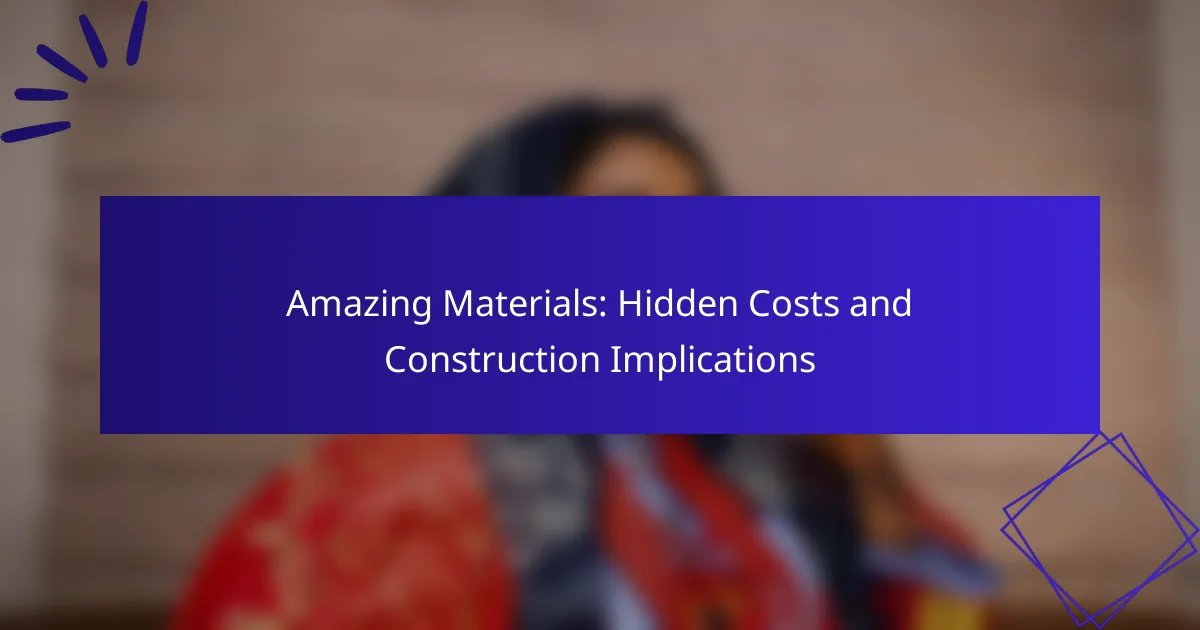The hidden costs of construction materials can greatly affect project budgets, often leading to unexpected financial burdens. Factors such as labor, transportation, and regulatory compliance contribute to these additional expenses, which may not be evident at the outset. Understanding the long-term implications of materials like steel, concrete, and insulation is crucial for effective budget management and project success.

What are the hidden costs of construction materials?
Hidden costs of construction materials can significantly impact overall project budgets. These costs often include labor, transportation, waste management, quality assurance, and regulatory compliance, which can add up quickly if not properly accounted for.
Labor costs
Labor costs are often underestimated in construction projects. Skilled labor is required for handling and installing various materials, and these costs can vary widely based on location and material complexity. For instance, specialized materials may require more experienced workers, leading to higher hourly rates.
Additionally, consider the potential for overtime pay if projects fall behind schedule. Budgeting for labor should include not only wages but also benefits and potential training costs for workers unfamiliar with specific materials.
Transportation fees
Transportation fees can add significant costs to construction projects, particularly for heavy or bulky materials. These fees depend on distance, weight, and the type of vehicle required for delivery. Local sourcing can help minimize these costs, while long-distance shipments may incur additional charges.
When planning, factor in the logistics of delivery schedules and potential delays that could lead to increased transportation expenses. Comparing quotes from multiple suppliers can also help identify the most cost-effective options.
Waste management expenses
Waste management expenses arise from the disposal of excess materials and construction debris. Proper disposal is crucial to comply with local regulations, which can vary by region. Failing to manage waste effectively can lead to fines and increased costs.
To mitigate waste management expenses, consider implementing a waste reduction plan. This could involve reusing materials on-site or recycling where possible, which can also contribute to sustainability goals.
Quality assurance costs
Quality assurance costs involve ensuring that materials meet specified standards and perform as expected. This may include testing materials before use, which can add to project timelines and budgets. Investing in quality assurance can prevent costly repairs or replacements later.
Consider establishing a quality control process early in the project. This can help identify issues before they escalate, saving both time and money in the long run.
Regulatory compliance fees
Regulatory compliance fees are essential to ensure that construction projects adhere to local building codes and safety regulations. These fees can include permits, inspections, and potential fines for non-compliance. Understanding local regulations is crucial to avoid unexpected costs.
Before starting a project, research the necessary permits and compliance requirements in your area. This proactive approach can help you budget accurately and avoid delays due to regulatory issues.

How do hidden costs affect project budgets?
Hidden costs can significantly impact project budgets by leading to unexpected expenses that were not initially accounted for. These costs can arise from various factors, including material price fluctuations, regulatory fees, and unforeseen labor requirements, ultimately straining financial resources.
Budget overruns
Budget overruns occur when actual expenses exceed the planned budget, often due to hidden costs. For instance, if the cost of materials rises unexpectedly, it can lead to overspending that may reach 10-20% of the original budget. Project managers should regularly review expenses and adjust forecasts to mitigate this risk.
To avoid budget overruns, it is crucial to include a contingency fund of around 5-15% of the total budget. This buffer can help absorb unforeseen costs without derailing the entire project.
Cash flow issues
Hidden costs can create cash flow issues, particularly if they arise late in the project. When unexpected expenses occur, they can disrupt the planned cash flow, making it challenging to pay suppliers or subcontractors on time. This can lead to strained relationships and potential project delays.
To manage cash flow effectively, maintain a detailed cash flow projection that includes potential hidden costs. Regularly update this projection to reflect changes in expenses and ensure that funds are available when needed.
Impact on project timelines
Hidden costs can also negatively affect project timelines, as delays may occur when additional funding is required to cover unexpected expenses. If a project runs out of budget, work may halt until new financing is secured, which can extend completion dates significantly.
To minimize timeline impacts, conduct thorough risk assessments at the project’s outset. Identify potential hidden costs and develop strategies to address them proactively, ensuring that timelines remain on track despite unforeseen challenges.

What materials have the highest hidden costs?
Materials such as steel, concrete, wood, and insulation often carry hidden costs that can significantly impact overall project budgets. These costs may arise from factors like maintenance, energy efficiency, and long-term durability, which are not always apparent during initial purchasing decisions.
Steel
Steel is known for its strength and durability, but its hidden costs can include corrosion treatment and ongoing maintenance. Projects in coastal areas, for example, may require additional protective coatings to prevent rust, which can add to the overall expense.
Additionally, fluctuations in steel prices can affect budgets, as they are influenced by global market conditions. It’s wise to consider these potential price changes and include a buffer in your budget to accommodate them.
Concrete
Concrete is a widely used construction material, but its hidden costs often stem from curing time and potential cracking issues. Proper curing is essential to prevent future structural problems, which may require additional labor and materials to address.
Moreover, the environmental impact of concrete production can lead to regulatory costs, particularly in regions with strict sustainability standards. Always check local regulations to ensure compliance and avoid fines.
Wood
While wood is a popular choice for its aesthetic appeal, hidden costs can arise from susceptibility to pests and moisture damage. Treatment against termites or mold can add to initial expenses, especially in humid climates.
Additionally, the price of wood can vary significantly based on species and sourcing practices. Opting for sustainably sourced wood may incur higher upfront costs but can lead to long-term savings through durability and reduced maintenance.
Insulation
Insulation is crucial for energy efficiency, but its hidden costs can include installation complexity and material quality. Higher-quality insulation materials may have a higher initial cost but can lead to significant savings on energy bills over time.
It’s important to consider the R-value, which measures insulation effectiveness. Investing in higher R-value insulation can reduce heating and cooling costs, making it a smart long-term investment despite higher upfront expenses.

How to mitigate hidden costs in construction?
To mitigate hidden costs in construction, it’s essential to conduct thorough assessments, maintain clear communication with suppliers, and plan for budget contingencies. These strategies help identify potential financial pitfalls early and ensure a smoother project execution.
Thorough material assessment
A comprehensive material assessment involves evaluating the quality, availability, and cost of materials before purchasing. This process helps to identify any hidden costs associated with sourcing, transportation, and potential delays.
Consider using a checklist that includes factors such as material specifications, supplier reliability, and market price fluctuations. Regularly updating this assessment can prevent unexpected expenses during construction.
Transparent supplier communication
Establishing transparent communication with suppliers is crucial for understanding pricing structures and potential hidden fees. Regular discussions can clarify terms and conditions, ensuring that all parties are aligned on expectations.
Ask suppliers for detailed quotes that break down costs, including shipping and handling. This practice can help uncover any additional charges that may arise later in the project.
Budget contingency planning
Budget contingency planning involves setting aside a portion of the overall budget to cover unforeseen expenses. A common recommendation is to allocate around 10-20% of the total budget for contingencies, depending on the project’s complexity.
Review past projects to identify common unexpected costs and adjust your contingency accordingly. This proactive approach can help absorb financial shocks without derailing the entire project.

What are the implications of using sustainable materials?
Using sustainable materials can significantly impact construction projects by reducing environmental footprints and enhancing long-term viability. These materials often lead to lower operational costs and can influence regulatory compliance and marketability.
Long-term cost savings
Sustainable materials can lead to substantial long-term cost savings through energy efficiency and reduced maintenance needs. For example, buildings constructed with high-quality insulation materials may see energy savings of 20-30% over their lifespan.
Investing in sustainable options may have higher upfront costs, but these are often offset by lower utility bills and fewer repairs. Consider materials like bamboo or recycled steel, which can provide durability and longevity, ultimately saving money over time.
Regulatory incentives
Many regions offer regulatory incentives for using sustainable materials, including tax credits, grants, or expedited permitting processes. These incentives can significantly reduce the effective cost of construction projects.
For instance, in the European Union, buildings that meet specific sustainability criteria may qualify for reduced VAT rates or financial support under various green building programs. It’s essential to research local regulations to take full advantage of these opportunities.
